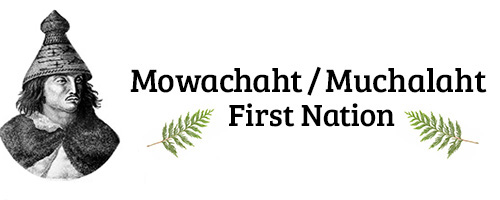
View of Yuquot village from the beach, drawn by artist with Capt. Cook, 1778.
Mowachaht trace their ancestors to Yuquot (“Where-the-wind-blows-from-all-directions”), the centre of our government and of our spiritual and ceremonial world. It is the longest continuously occupied site on the west coast of Vancouver Island. It is one of the largest and deepest archaeological deposits in British Columbia.

Google Earth Map showing Mowachaht and Muchalaht villages.
Every inch of Nootka Sound is represented at Yuquot. Thirteen Mowachaht extended family groups each owned a bighouse at Yuquot. The ha’wilth of each group owned a separate territory and its resources. The chiefs also owned other rights including village sites, fishing and hunting rights, songs, names, dances, and group history. The highest-ranked Mowachaht ha’wiih, ta’yii ha’wilth Maquinna, gave the other ha’wiih the right to build their houses at Yuquot.

Illustration of Mowachaht people welcoming members of 1791 Malaspina Expedition at Yuquot.
Our community also had honoured “specialists” such as Speaker/Historian, Lead Singer, Weather Watcher, Beachowner, Warrior/Guardian and Peacekeeper. Our muschiim, or commoners, were the backbone of our community, providing essential services.

Illustration of Cook’s anchorage near Yuquot on Bligh Island, 1778.
For a short time, Yuquot was also an important centre for the mamatni (white people). A Spanish naval ship, exploring the coast of what became British Columbia, arrived off Nootka Sound in 1774.The first mamatni to come ashore were men with Captain James Cook, who arrived in 1778; he repaired his ships in a cove in our hahoothlee, at what is now commonly known at Resolution Cove on Bligh Island. We enjoyed good relations with these visitors and traded fish, furs and everyday things from cooking utensils to hats, capes and ceremonial items in return for metal and clothing.

